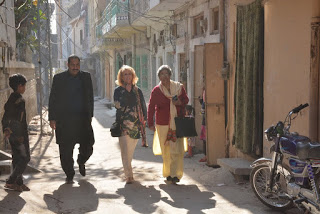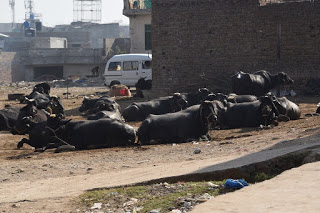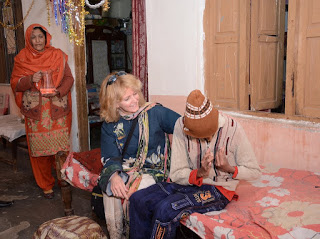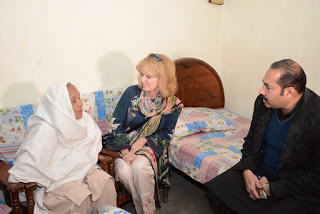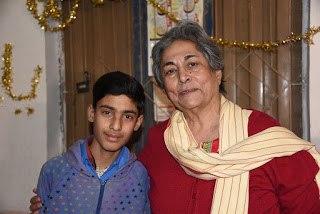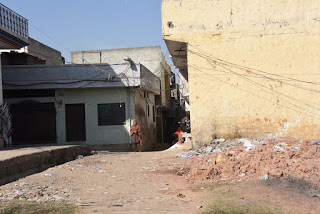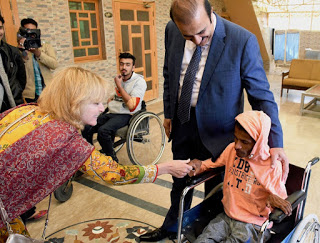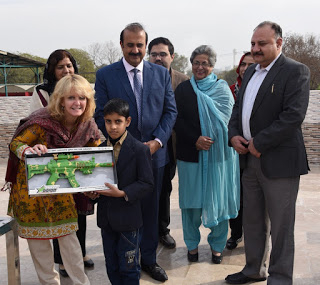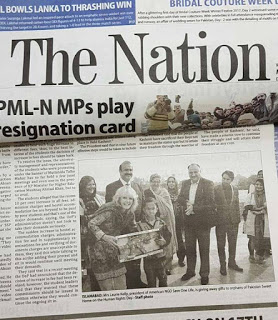1,376
Thursday December 7, 2017
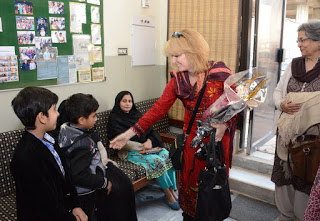 |
| Laurie Kelley receiving flowers |
As I sat at the bus terminal in Lahore, Pakistan, I
spied in the waiting area a tall Pakistani soldier gazing at his newborn baby.
What a photo that would have made! Him in his khaki and green uniform, she,
barely a month old, in pink, cradled in his arms while he studied every bit of
her face, to remember her before he left for duty. To see this soldier at such
an intimate moment was precious. Too often we label people, but at their core,
most people want the same things: peace, family, love, a chance to work and
take care of their families.
spied in the waiting area a tall Pakistani soldier gazing at his newborn baby.
What a photo that would have made! Him in his khaki and green uniform, she,
barely a month old, in pink, cradled in his arms while he studied every bit of
her face, to remember her before he left for duty. To see this soldier at such
an intimate moment was precious. Too often we label people, but at their core,
most people want the same things: peace, family, love, a chance to work and
take care of their families.
I then boarded a luxury bus to
Islamabad, the capital of Pakistan. I passed by thousands of acres of flat,
arid land, mostly dusty, with trees bordering farms. A very agrarian scene,
with dusty brick homes, farmlands, cows, and goats.
Islamabad, the capital of Pakistan. I passed by thousands of acres of flat,
arid land, mostly dusty, with trees bordering farms. A very agrarian scene,
with dusty brick homes, farmlands, cows, and goats.
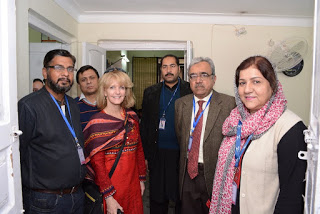 |
| Laurie Kelley with Rawalpindi Chapter team |
After the four-hour ride, I was
in Islamabad, a stunningly beautiful city, laid out in a grid like our capital.
When I exited the bus… there was Anjum Malik! I had not seen him in 10 years,
but it was like no time had passed. He works for a distributor of drugs in
Pakistan, but has been a stalwart friend to the hemophilia community from the beginning.
We chatted on the way to Dr. Munawar’s house. She is a retired physician, and president
of the Rawalpindi chapter of the PHPWS. When we met, it was as if we had known
one another our whole lives. It makes no difference that we are from different countries
or cultures—we are here to help those who suffer, so we are sisters! Her home
is lovely and no guest room could be better.
in Islamabad, a stunningly beautiful city, laid out in a grid like our capital.
When I exited the bus… there was Anjum Malik! I had not seen him in 10 years,
but it was like no time had passed. He works for a distributor of drugs in
Pakistan, but has been a stalwart friend to the hemophilia community from the beginning.
We chatted on the way to Dr. Munawar’s house. She is a retired physician, and president
of the Rawalpindi chapter of the PHPWS. When we met, it was as if we had known
one another our whole lives. It makes no difference that we are from different countries
or cultures—we are here to help those who suffer, so we are sisters! Her home
is lovely and no guest room could be better.
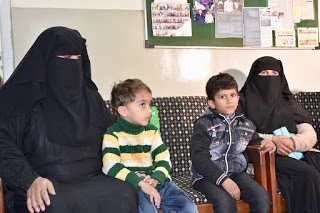 |
| Mothers wait with children with hemophilia for infusions |
After settling in, we drove to
the Hemophilia Patients Welfare Society headquarters, where black-robed mothers sat with their small children, only their
eyes visible through the niqab. As
this is my fourth visit to Pakistan, this no longer seems strange to me. We
smiled at each other and shook hands. The staff greeted me with flowers, and we
had some tea and got acquainted.
the Hemophilia Patients Welfare Society headquarters, where black-robed mothers sat with their small children, only their
eyes visible through the niqab. As
this is my fourth visit to Pakistan, this no longer seems strange to me. We
smiled at each other and shook hands. The staff greeted me with flowers, and we
had some tea and got acquainted.
We decided to see some families
right away while we had light. First stop, Hazma Quereshi, who is sponsored by
my friend and colleague Patrick Schmidt, president of FFF Enterprises. Hazma is
a tall, handsome young man with VWD type 1. He wants to go to school for IT
training. We didn’t spend much time with him, but his family was lovely and welcoming,
as all Pakistanis seem to be. Hazma lives in a nice home, made of concrete,
with several rooms.
right away while we had light. First stop, Hazma Quereshi, who is sponsored by
my friend and colleague Patrick Schmidt, president of FFF Enterprises. Hazma is
a tall, handsome young man with VWD type 1. He wants to go to school for IT
training. We didn’t spend much time with him, but his family was lovely and welcoming,
as all Pakistanis seem to be. Hazma lives in a nice home, made of concrete,
with several rooms.
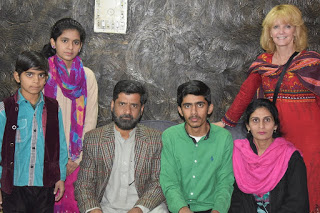 |
| Laurie Kelley with Hamza and family |
Then off to Mohammad Saad’s house.
He’s sponsored by my friend and colleague Kyle Callahan. We walked down a dirt
road alley, past staring children, as twilight turned to night. We found his
door and then scaled up high, cold concrete stairs, and at the top was Gulsam, his
grandmother, a robust, very loud woman, jabbering away in a husky voice! What
character: she clearly rules the roost! Saeed was shy at the outset, head down,
quiet. He has two sisters, one of whom is a twin. He’s had 5-6 elbow bleeds in
the past year, and gum bleeds due to tooth losses. He won’t wear shoes, Gulsam
lamented, and indeed, looking at his toes, they were blue, and two had frostnip
on them! There are six children, including a new baby Muhammad Ali, who also
has hemophilia. We will get him registered with Save One Life. Munawar and
Gulsam had a lively and friendly exchange in Urdu, and we filed out of the
house. Now it was night, and we passed a little vendor shop on the corner
selling slabs of meat, young people on motorbikes, and children who fell in
line to follow us.
He’s sponsored by my friend and colleague Kyle Callahan. We walked down a dirt
road alley, past staring children, as twilight turned to night. We found his
door and then scaled up high, cold concrete stairs, and at the top was Gulsam, his
grandmother, a robust, very loud woman, jabbering away in a husky voice! What
character: she clearly rules the roost! Saeed was shy at the outset, head down,
quiet. He has two sisters, one of whom is a twin. He’s had 5-6 elbow bleeds in
the past year, and gum bleeds due to tooth losses. He won’t wear shoes, Gulsam
lamented, and indeed, looking at his toes, they were blue, and two had frostnip
on them! There are six children, including a new baby Muhammad Ali, who also
has hemophilia. We will get him registered with Save One Life. Munawar and
Gulsam had a lively and friendly exchange in Urdu, and we filed out of the
house. Now it was night, and we passed a little vendor shop on the corner
selling slabs of meat, young people on motorbikes, and children who fell in
line to follow us.
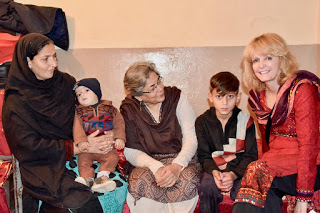 |
| Dr. Munawar and Laurie with Saeed |
The third house we visited was
that of Faryal Tabassum (sponsored by my friend and colleague since 1990, Alison
Arter!). Up to the second floor again. Faryal is sweet, with her head covered
modestly, and a wise expression on her face. She has Glanzmann’s disease. In
2005, she and her family lived in the Kashmir section of Pakistan, when on
October 8 a 7.5 magnitude earthquake struck; 86,000 died. 15-20 family members
died, including her 3-year-old brother. The family moved to Rawalpindi for
another home and to get treatment. Her father doesn’t have a regular job; he
now waits tables but must search for new jobs all the time. He earns about $2 a
day. They rent 2 rooms in the place they are now. I gave the mother $100, about
2 months’ rent, to help them out. But the children look well cared for, clean
and happy. The grandparents were present; the grandmother was on the bed sick.
that of Faryal Tabassum (sponsored by my friend and colleague since 1990, Alison
Arter!). Up to the second floor again. Faryal is sweet, with her head covered
modestly, and a wise expression on her face. She has Glanzmann’s disease. In
2005, she and her family lived in the Kashmir section of Pakistan, when on
October 8 a 7.5 magnitude earthquake struck; 86,000 died. 15-20 family members
died, including her 3-year-old brother. The family moved to Rawalpindi for
another home and to get treatment. Her father doesn’t have a regular job; he
now waits tables but must search for new jobs all the time. He earns about $2 a
day. They rent 2 rooms in the place they are now. I gave the mother $100, about
2 months’ rent, to help them out. But the children look well cared for, clean
and happy. The grandparents were present; the grandmother was on the bed sick.
It was a sober ride back, thinking
of their financial struggles, while we felt richer having visited these
beautiful children and young adults, so eager to have a normal life.
of their financial struggles, while we felt richer having visited these
beautiful children and young adults, so eager to have a normal life.
Friday December 8, 2017
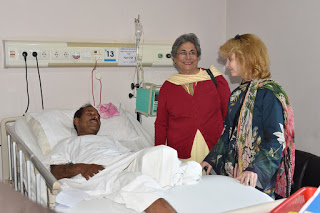 |
| Laurie Kelley and Dr. Munawar visit Sheeraz |
After breakfast we left this
morning for the hospital: a beautiful, private one to see Sheeraz, who had an
amputation just the day before. He used the 50,000 IU that we had sent. He was
in a beautiful room, bright and sunny, lying in bed, his truncated leg propped
up. His entire family was there to see him: two elegant, beautiful women in the
prettiest of dresses, and two older men. They all thanked me over and over for
the factor. “Words cannot express our gratitude,” the elder brother said. I
thought of how nice the world can be, with us helping one another.
morning for the hospital: a beautiful, private one to see Sheeraz, who had an
amputation just the day before. He used the 50,000 IU that we had sent. He was
in a beautiful room, bright and sunny, lying in bed, his truncated leg propped
up. His entire family was there to see him: two elegant, beautiful women in the
prettiest of dresses, and two older men. They all thanked me over and over for
the factor. “Words cannot express our gratitude,” the elder brother said. I
thought of how nice the world can be, with us helping one another.
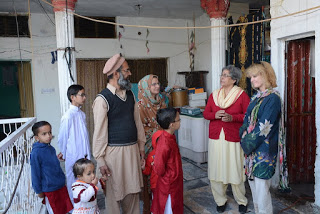 |
| With Azib and family |
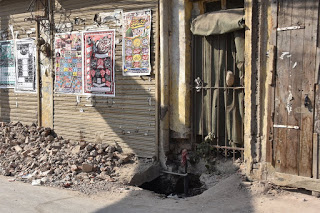 |
| Doorway on street with interesting colors and textures |
By 9:30 am we headed for the
Society office again for tea. Khawar Yasin was there, who I had met in 2007. He
has a brother with hemophilia. I also met Fayyaz, who has hemophilia. Then we drove
off to visit more patients. First Azib, my sponsored child! He’s 10 but looks
like about 6. Very small in stature, with glasses that made him look like Harry
Potter. The family lives in a large concrete home that houses the extended
family: this is quite typical in Pakistan, as a way to protect the longevity of
the family. This is also why families intermarry. Because hemophilia ran in the
family (Azib’s three maternal uncles have hemophilia) his mother married
outside the family. They come to the society for factor about once a month, on
a motorbike, which takes about 20 minutes. Azib does well in school. He had typhoid
a few months ago and is still recovering. The father was so kind: he poured us
tea, which was delicious, and then his wife brought out food. Normally I don’t
eat at each home, but I tried this, and it was the best thing I ever ate in
Pakistan! Very sweet with a texture like steel cut oats. It’s called suji halwa.
We were all crowded into one
room, where the grandfather had been sleeping, and he was sick. He sat up with
help, and I saw a dark-skin, weathered man, with bundles of blankets on him. This
is their life—no privacy. They all act with restraint, civility because they
are all together. Kind of like being on an airplane, where we must all act and
behave well or else we will all be in trouble. This is a lovely family, and
there is much hope for Azib to do well in life, and through our program.
room, where the grandfather had been sleeping, and he was sick. He sat up with
help, and I saw a dark-skin, weathered man, with bundles of blankets on him. This
is their life—no privacy. They all act with restraint, civility because they
are all together. Kind of like being on an airplane, where we must all act and
behave well or else we will all be in trouble. This is a lovely family, and
there is much hope for Azib to do well in life, and through our program.
After a nice visit there, we
moved on to see Danish and Usman, cousins who live in the same housing complex.
We had to walk down some alleys, until we saw to our right a big lot, filled
with black bulls, lying in the dirt. To our left, their home. When we walked
in, pandemonium—the two sisters, who I had met in 2007—cried and cried, hugging
me, babbling in Urdu, then the grandmother joined in, crying and hugging. They
were so happy to see me, and to welcome me to their home! They finally calmed
down and we got to see Danish, who is tall now. Danish is severely
developmentally delayed, but he knows what’s going on. He’s so shy! He kept
looking at me sideways but then turning his head and smiling, rubbing his hands
over and over. I worked with children like this in my 20s at a state
institution, so it was easy to chat with him, hold his hand, try to get him to
trust me.
moved on to see Danish and Usman, cousins who live in the same housing complex.
We had to walk down some alleys, until we saw to our right a big lot, filled
with black bulls, lying in the dirt. To our left, their home. When we walked
in, pandemonium—the two sisters, who I had met in 2007—cried and cried, hugging
me, babbling in Urdu, then the grandmother joined in, crying and hugging. They
were so happy to see me, and to welcome me to their home! They finally calmed
down and we got to see Danish, who is tall now. Danish is severely
developmentally delayed, but he knows what’s going on. He’s so shy! He kept
looking at me sideways but then turning his head and smiling, rubbing his hands
over and over. I worked with children like this in my 20s at a state
institution, so it was easy to chat with him, hold his hand, try to get him to
trust me.
Photos: Going to Danish’s home; Dr. Munawar with Usman
Finally I wanted to speak with
Usman, but it was impossible with the mom and aunt around. I had them shooed
out and we got to sit with Usman and his adorably cute cousin. We stayed and
chatted, and learned that Usman wants to be a doctor someday. The grandmother
pulled out a picture of her son, who died in 2006, leaving Usman without a father.
I ended up giving them $100.
Usman, but it was impossible with the mom and aunt around. I had them shooed
out and we got to sit with Usman and his adorably cute cousin. We stayed and
chatted, and learned that Usman wants to be a doctor someday. The grandmother
pulled out a picture of her son, who died in 2006, leaving Usman without a father.
I ended up giving them $100.
It was a productive visit. On the
way out, we decided to go check out the bulls. People stopped and stared but I
waved and smiled and everyone smiled and waved back. They were all so nice!
way out, we decided to go check out the bulls. People stopped and stared but I
waved and smiled and everyone smiled and waved back. They were all so nice!
Saturday December 9, 2017
 My last day in Pakistan. Up early
My last day in Pakistan. Up earlyagain, at 5:30 am, to the sounds of the muezzin
chanting the prayers. I wouldn’t lie down again until (Pakistan time) 4:30
Monday morning!
Today we drove off to Pakistan
Sweet Homes, to have a celebration with the families and to disburse Save One
Life funds to reach beneficiary. I was told it was a place for orphans, but the
executive director and founder offered it to us for the day. I had no idea what
to expect and I was amazed. It’s a
compound of staggering engineering and efficiency, an incredible oasis of hope
for orphans. The complex has everything: mosque, meeting rooms, dorms,
schoolroom, dining room, huge sports field and bleachers for hundreds of
children. The founder, Zammurd Khan joined us. He’s 6’3”, light and fast on his
feet despite his height, self-deprecating but still can claim the limelight
wherever he goes and in all his promotional material. He is a celebrity. We
watched a DVD on the founding of Pakistan Sweet Home, which was impressive, especially
when it showed how Khan jumped into the middle of a street shootout over a kidnapped
child and rescued the child!
Sweet Homes, to have a celebration with the families and to disburse Save One
Life funds to reach beneficiary. I was told it was a place for orphans, but the
executive director and founder offered it to us for the day. I had no idea what
to expect and I was amazed. It’s a
compound of staggering engineering and efficiency, an incredible oasis of hope
for orphans. The complex has everything: mosque, meeting rooms, dorms,
schoolroom, dining room, huge sports field and bleachers for hundreds of
children. The founder, Zammurd Khan joined us. He’s 6’3”, light and fast on his
feet despite his height, self-deprecating but still can claim the limelight
wherever he goes and in all his promotional material. He is a celebrity. We
watched a DVD on the founding of Pakistan Sweet Home, which was impressive, especially
when it showed how Khan jumped into the middle of a street shootout over a kidnapped
child and rescued the child!
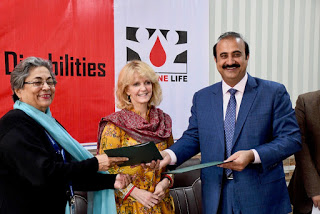 |
| Laurie Kelley, Dr. Munawar with Zammurd Khan |
Eventually we got on to our
celebration. Many hemophilia families came and we had speeches, with the most
riveting by Dr. Nadeem, who kindly remembered the late Saif ul Islam, former
president of the chapter, who died this year. I knew Saif since 1999, and
considered him my friend. We each have three children, the same age, and I
suppose that helped us bond, along with our desire to improve the lives of
those who suffer with hemophilia. We keenly felt his loss then and there, and
when Dr. Nadeem said, “He had an active professional career in the Pakistan Navy.
With great effort, he transformed his scars into stars. A mammoth gathering of
his lovers, friends, fellows, and family members on the occasion of his funeral
prayers put a stamp on his faithfulness, religiosity, and humility,” I saw his
adult son in the front row shed tears.
celebration. Many hemophilia families came and we had speeches, with the most
riveting by Dr. Nadeem, who kindly remembered the late Saif ul Islam, former
president of the chapter, who died this year. I knew Saif since 1999, and
considered him my friend. We each have three children, the same age, and I
suppose that helped us bond, along with our desire to improve the lives of
those who suffer with hemophilia. We keenly felt his loss then and there, and
when Dr. Nadeem said, “He had an active professional career in the Pakistan Navy.
With great effort, he transformed his scars into stars. A mammoth gathering of
his lovers, friends, fellows, and family members on the occasion of his funeral
prayers put a stamp on his faithfulness, religiosity, and humility,” I saw his
adult son in the front row shed tears.
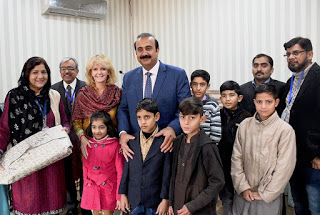 |
| With the Save One Life beneficiaries |
Eventually we had the families
line up and gave each of our beneficiaries for Save One Life their funds. This was followed by lunch outside in the
sunshine and a tour of the expansive facilities.
line up and gave each of our beneficiaries for Save One Life their funds. This was followed by lunch outside in the
sunshine and a tour of the expansive facilities.
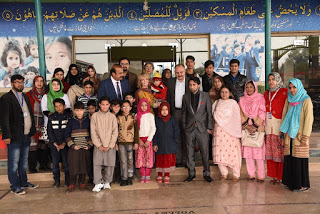 Back inside, the families mostly
Back inside, the families mostlyleft, and I met with the Youth and Women’s Groups. I noticed how much everyone
lectures here, so I changed it up and had them sit in a circle, and asked each
of them to state what their 5-year vision was for their group. This was great,
because rather than just sit and listen, they all participated. I looked for
themes in what they all said… lobbying the government to give support became a
dominant theme. Somehow we tied it all in together and then I asked for goals,
a breakdown of their lofty vision. It was a good exercise, and they caught on
about how to take ideas and turn them into tangible goals. The more we
discussed, the more the young people got energetic, and discussed more, and
when it was done, everyone seemed pumped up.
So the entire day concluded on a
very high note; goal setting often does that!
very high note; goal setting often does that!
Back to Munawar’s home, where I
relaxed for a bit before Anjum retuned to take me to the airport. It was a
bittersweet trip and departure. I truly love visiting Pakistan. Some people in
America don’t understand how I can love Pakistan, but if you haven’t
experienced a visit there, felt the kindness, the hospitality that can embarrass
you when you realize it supersedes your own, the civility, then it would be
hard to judge. Some of the best people you could ever meet in hemophilia live
in this ancient land. And I can’t wait to return.
relaxed for a bit before Anjum retuned to take me to the airport. It was a
bittersweet trip and departure. I truly love visiting Pakistan. Some people in
America don’t understand how I can love Pakistan, but if you haven’t
experienced a visit there, felt the kindness, the hospitality that can embarrass
you when you realize it supersedes your own, the civility, then it would be
hard to judge. Some of the best people you could ever meet in hemophilia live
in this ancient land. And I can’t wait to return.

